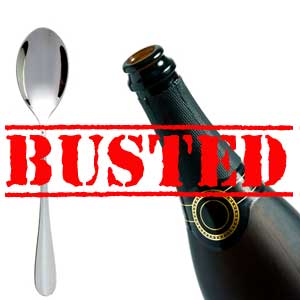We all drink it by the bucket-load – no, wait – that’s just me. Well, many of us enjoy a nice glass of wine from time to time anyway and, whilst we obviously don’t need to be complete wine fundis to take pleasure in a good glass of Sauvignon or Cabernet, it certainly doesn’t harm to have an idea or two about what we are actually drinking.
Sadly, the wine industry has surrounded itself for years with an aura of mystique and exclusivity which is both unhelpful and intimidating, and this has led to a lot of different and sometimes strange ideas arising and solidifying over the years.
So here are a few of them – busted for you. Happy drinking!
1. A corked wine has pieces of cork in it – nope, that just means the waiter needs some more training! A corked wine is where the actual cork has become infected with a mould called Trichloranisole or TCA. This reacts with the flavour compounds in the wine and turns the wine mouldy, stinky and off. It won’t kill you if you drink it accidentally – but it won’t taste good, that’s for sure!
2. A screwcapped wine can’t be corked – well, it obviously hasn’t got a cork in it but yes, it can be affected by TCA. If the mould is present in the winery and strict hygiene isn’t maintained at every stage, then a wine which is closed by a screwcap can be affected by cork taint too.
3. Sauvignon Blanc should be drunk the same year it’s made – not necessarily. This is a bit of a tricky one because Southern Hemisphere Sauvignons can be almost 10 months old at the end of their year of vintage and some of them will definitely be drinking well during that time. Good rule of thumb – if it’s less than R40 a bottle, crack it open now. But if it’s over R60 or so, then there’s every chance it will be better at least a year after vintage when the acids will have had a chance to settle down a bit.
4. A teaspoon in an open bottle of fizz will keep the bubbles in it – I have no idea where this one came from, but in my opinion it’s unmitigated rubbish. For a start – having any leftover fizz is a crime anyway, but the only sure way to keep the bubbles in is to use a proper champagne stopper. Drink it or seal it properly – it’s the only way.
5. Sniffing the cork can tell you if the wine is faulty or not – No, sniffing the cork will tell you it smells of cork – and nothing else. If you’re looking for faults – cork taint, oxidation, volatile acidity etc – then smell and taste the wine. The only reasons waiters show you the cork is so that you can verify that the name on it is the same as the wine in the bottle and also so you can check that one end of the cork is wet indicating the bottle has been properly stored on its side.
6. You should always cook with the wine you’d be prepared to drink with the meal – Let’s get real folks – who on earth can afford to do that? If I’ve splurged R100+ on a special bottle of wine to drink with dinner, I am definitely not going to spend R200 and buy a second one to pour in the pot. For the most part, wine used in cooking merely adds some non-specific ‘wine’ flavours – flavours which can equally well be achieved by box wine. So use a box wine and save your money for something which can be enjoyed in full and not just as one of a whole host of flavours in a stew. Promise you no-one’s ever noticed the difference in my cooking!
Got any other things you always thought you knew about wine? Share them with us below and we’ll see if it’s real or rotten!
Follow @food24 and @CathyMarston on twitter.

